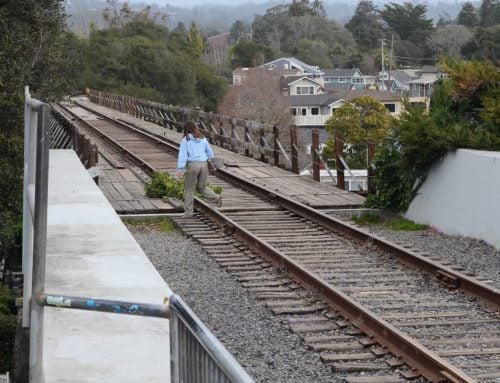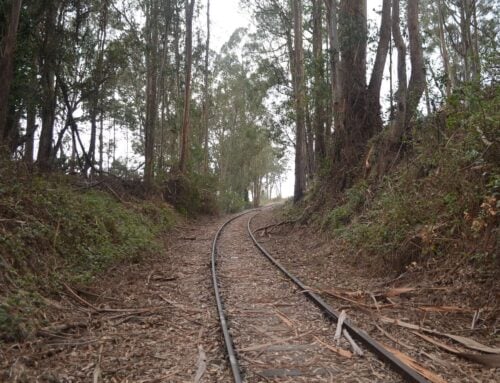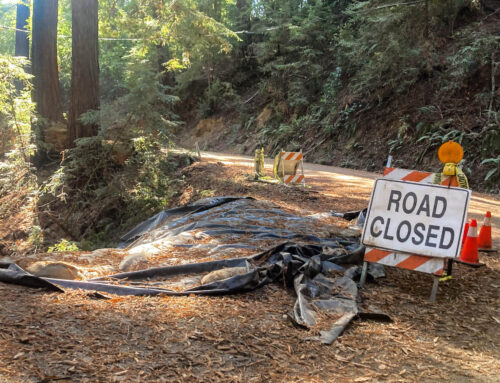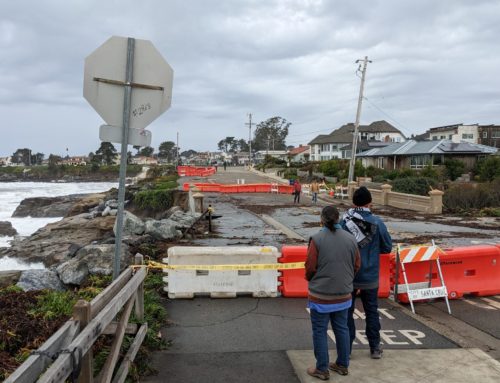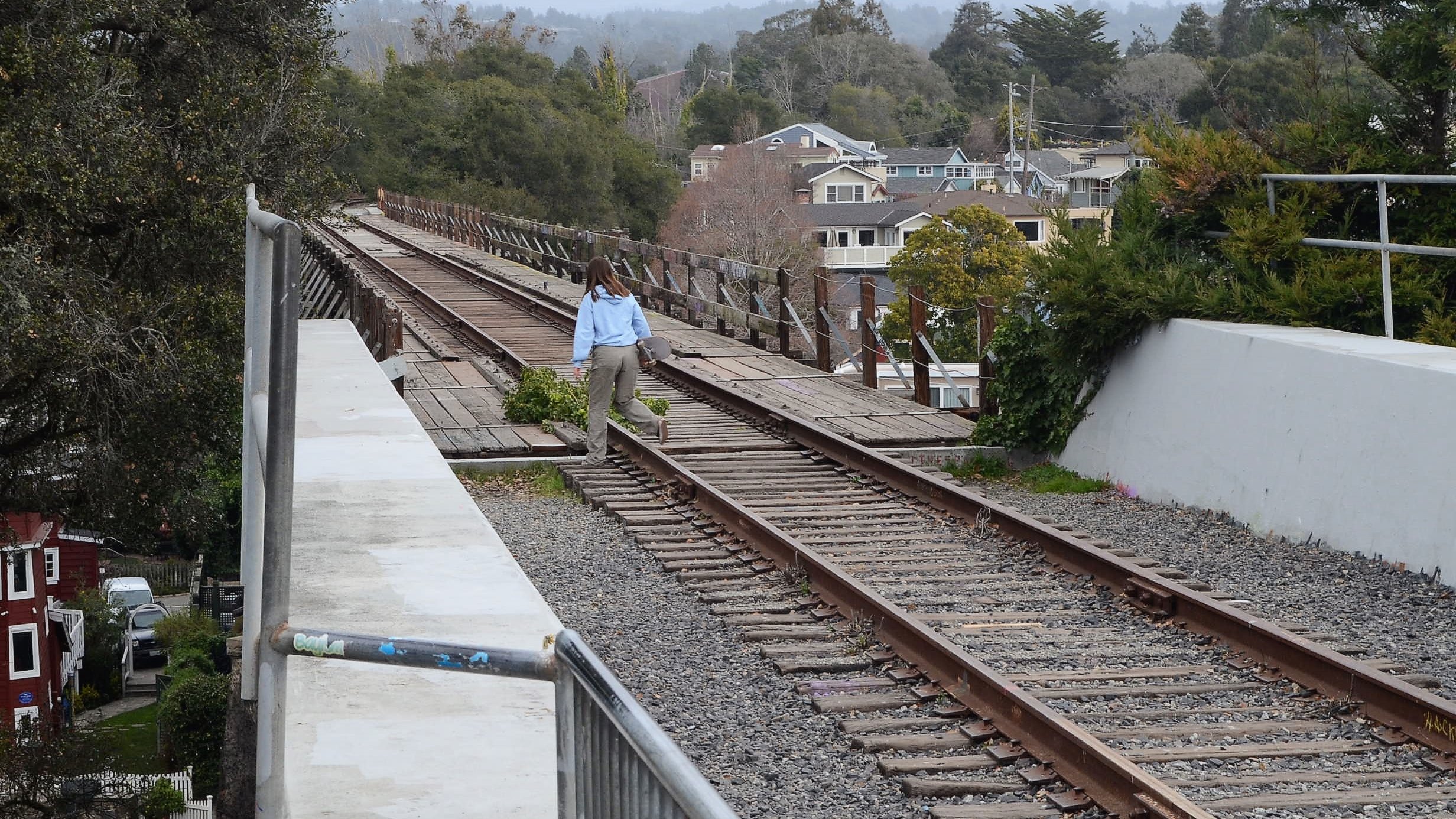
Santa Cruz County Regional Transportation Commission staff have described an interim plan to pave a path where the tracks now run on the Capitola trestle. (Stephen Baxter — Santa Cruz Local file)
SANTA CRUZ >> In a 15-page report released March 2, Santa Cruz County staff tried to clarify how a June ballot measure would impact county government and a planned trail on the Santa Cruz Branch Rail Line.
The ballot measure, spurred by local nonprofit Santa Cruz County Greenway Inc. and more than 12,000 valid signatures, would change the county’s General Plan to promote Greenway’s vision for a trail: two lanes of bike traffic, a divider and a walkway. Current plans call for bikers and walkers to share a path next to the tracks in most places and possibly build a path on the rail line in some narrow sections.
Regardless of whether voters approve the ballot measure, staff of the Santa Cruz County Regional Transportation Commission have proposed an “interim plan” to build a path next to the tracks and temporarily replace the railroad tracks with a paved path on some narrow parts of the line. The plan is to return the rails later for potential rail transit.
If voters approve the measure, it would not force construction of a path on the rail line, nor would it rule out the possibility of future passenger rail service on the rail corridor, county officials wrote.
County staff wrote the report to help Santa Cruz County supervisors understand the potential impact if voters approve an initiative from Greenway on the June 7 ballot. County supervisors are expected to place the measure on the ballot during their meeting Tuesday, March 8.
The report helped clarify what voters will decide.
- Voter approval would not rule out the possibility of future passenger rail service on the rail corridor, county staff wrote.
- Voter approval would not force construction of a paved path and removal of the tracks. Rather, it would change language in Santa Cruz County’s General Plan toward a multi-purpose trail. “The overall impact is to remove language that plans for the [rail] corridor to be used for rail and recreational and active transportation purposes and replace it with language designed to plan for the corridor to be used as a multi-purpose trail,” county leaders wrote.
- Voter approval would change Santa Cruz County’s General Plan only on segments of the Santa Cruz Branch Rail line in unincorporated areas of the county — places such as Live Oak and Aptos. It would not apply to rail line areas in the cities of Santa Cruz, Capitola or Watsonville because the ballot measure’s language does not touch those cities.
- The plans described in the ballot initiative are similar to the most recent proposal from staff of the Santa Cruz County Regional Transportation Commission. Regardless of whether voters approve the June ballot initiative, the commission staff’s “interim” plan also outlines a paved path on some parts of the rail line and parallel to it in other parts. Wide points would allow a path next to the train tracks, but narrower parts would necessitate a paved path where the tracks now run because of legal and engineering reasons, transportation commission staff have said. Transportation commission staff plan to present workshops this spring to gather public feedback on the plans. The regional transportation commission has not yet voted whether to pursue the “interim” plan or a “single-build” plan that would build the entire trail next to the tracks.
- Voter approval of the Greenway initiative would support railbanking of the rail line. Greenway’s paved path is dependent on railbanking, county staff wrote. A decision on railbanking is “outside of the county’s jurisdiction or ability to control,” the county report states. The Santa Cruz County Regional Transportation Commission owns the Santa Cruz Branch Rail Line and federal authorities govern the railbanking process, the county report states.
Railbanking issues
Railbanking is a process that allows the railroad to be converted to a trail. Railbanking allows the possibility of future rail use on the corridor, said Guy Preston, the transportation commission’s executive director. Railbanking is also part of the latest proposal from the staff of the regional transportation commission.
Preston, the transportation commission’s executive director, said Feb. 17 that railbanking is “not going to be something that’s easy to do.” But if it is pursued, Preston said his intent is to return the tracks.
Regardless of the ballot initiative outcome, regional transportation commissioners also are expected to decide between an “interim” plan and “ultimate” plan. The interim plan would allow a paved path to replace some sections of the train tracks, while the “ultimate plan” would build the path next to the rail line. Preston and even the most enthusiastic supporters of the “ultimate plan” have said it will take tens of millions more dollars and likely decades to create passenger rail service. Many parts of the line would have to be repaired.
Railbanking is outside the county’s control because the U.S. Surface Transportation Board oversees whether a railroad operator and a trail agency can agree to use a freight rail corridor as a trail until a railroad returns to freight service, the March 2 county report states.
“For railbanking to occur, a Notice of Abandonment would need to be filed with the Surface Transportation Board,” the county report states. The freight easement holder, which is Saint Paul and Pacific Railroad, typically files the notice. Saint Paul filed a notice of intent to abandon the line, but has not moved forward “due to potential objections,” county staff wrote.
“Railbanking would be more feasible and simplified if affected parties could reach a mutual agreement. If not, the [regional transportation commission] could file with the Surface Transportation Board to attempt to force abandonment. If the corridor is unable to be railbanked, any interim trail that requires the removal of the railroad tracks would be infeasible,” county staff wrote.
Ballot initiative impacts on county money, planning and infrastructure
The March 2 county report also touched on potential fiscal impacts to the county, as well as potential ripples across county planning, zoning, land use, infrastructure funding, business investment and other areas.
- County fiscal impact: The report states there is no immediate money impact to the county if the initiative is approved. However, “overall long-term costs would be higher because a trail constructed on the railroad track alignment would need to be removed, the rail line reconstructed, and a new trail built next to the rail line if the line is restored for future rail use,” the report states.
- Planning and zoning impact: The ballot initiative is essentially consistent with county planning and zoning. The Sustainable Santa Cruz County Plan does not envision the “Greenway concept for the [rail] corridor,” but its inclusion of railbanking is consistent with the plan, the report states. “Most land uses are likely to realize a benefit from either the interim trail or a trail with rail configuration,” the report states.
- Impact on transportation infrastructure and maintenance: A path is likely to increase the number of cyclists and walkers on the corridor and at access points. About 2% to 3% of vehicle travel — or about 5,000 vehicle trips per day — could be reduced with a path, according to an estimate in a 2013 environmental impact report for a similar countywide bike and walk path. The June 7 ballot initiative could mean a wider paved path than one described by transportation commission staff, county staff wrote. A wider trail could mean more maintenance costs by the county. However, a path on the rail line — rather than next to it — would require fewer retaining walls, bridges and other infrastructure, the report states.
- Business investment impact: “Because the initiative does not actually compel development to take place, the initiative itself likely has a limited impact in attracting or retaining business and employment,” the report states. “Freight service is currently not available on the section of the corridor that is the subject of the Greenway initiative and there is a lack of identified funding to make improvements and repairs needed to support such service in the future. The availability of freight service is therefore not considered a factor in the community’s ability to attract and retain business and employment,” the report states.
- Housing impact: “The initiative is unlikely to be a significant factor in the county’s ability to comply with housing law and to approve housing developments, including equitable/affordable housing access, residentially zoned land, streamlined review, and use of density bonuses,” the report states. Density bonuses essentially allow developers to build more housing units on land than the zoning would normally allow if a number of affordable units are included in the project.
- Vacant land impact. “Many commercial, residential, and mixed-use developments that might be built on currently vacant parcels would realize a general benefit from the amenity of either an interim trail or a trail with rail configuration that could serve employees, patrons, and residents. Determining which of these two uses of the corridor would yield more potential benefit is speculative, since it is not possible to know the type and scale of development that will occur on specific vacant parcels, particularly since mixed use allows a residential component to occur on commercially zoned parcels,” the report states.
Santa Cruz Local’s news is free. Our newsroom relies on locals like you for financial support. Our members make regular contributions, starting at $19 a month or $199 year.
Stephen Baxter is a co-founder and editor of Santa Cruz Local. He covers Santa Cruz County government.


